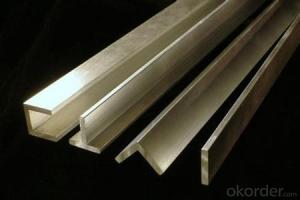ANOZED ALU PROFILE
OKorder Service Pledge
OKorder Financial Service
You Might Also Like
Aluminium is a relatively soft, durable, lightweight, ductileand malleablemetalwith appearance ranging from silvery to dull gray, depending on the surfaceroughness. It is nonmagnetic and does not easily ignite. A fresh film ofaluminium serves as a good reflector (approximately 92%) of visible lightand an excellent reflector (as much as 98%) of medium and far infraredradiation. The yield strength of pure aluminium is 7–11 MPa,while aluminium alloys have yield strengths ranging from200 MPa to 600 MPa. Aluminium has about one-third the densityand stiffness of steel. It is easily machined,cast, drawn and extruded.
Features:
Material | Alloy 6063,6061,6005or according to customer’s choice |
Temper | T3, T4, T5, T6 |
Surface | Anodize, electrophoresis, powder coating, PVDF coating, wood grain painting, matted, etc. |
Length | Coating 6.5 meters, Anodizing 6.5 meters, Mill finish 5 meters |
Application | Industrial, electrical equipment(TV set, air conditioner, refrigerator, computer), decoration,construction, transportation |
Custom Made | We can package following with customer's request. |
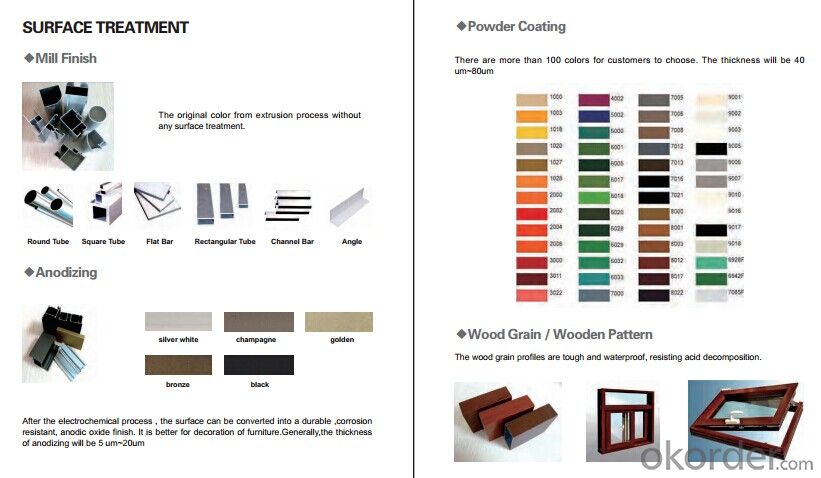

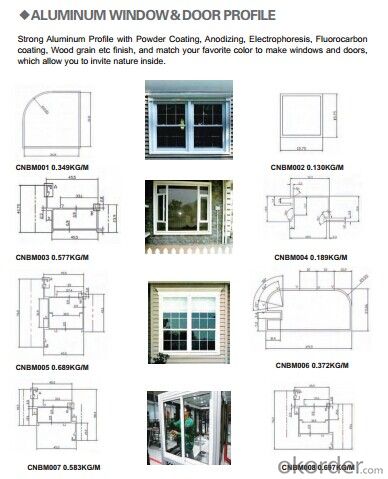
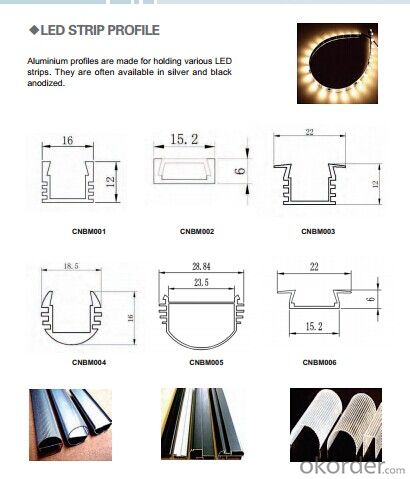
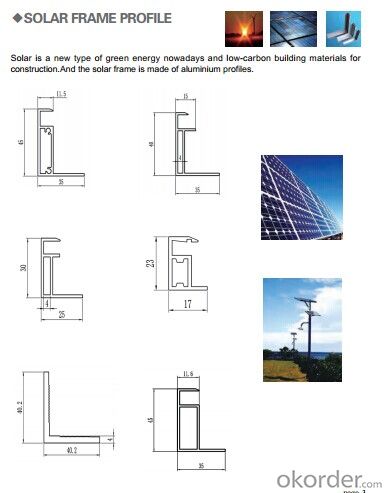
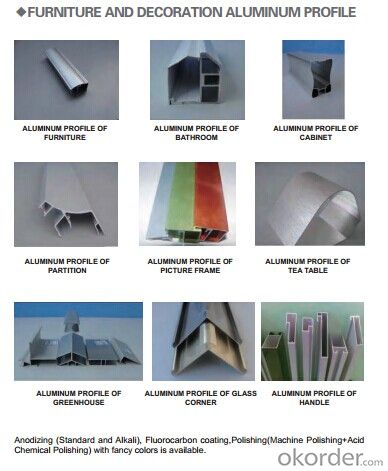
- Q:How do you select the appropriate aluminum profile for a specific application?
- To select the appropriate aluminum profile for a specific application, one must consider several factors. Firstly, the desired strength and durability of the profile should match the requirements of the application. The profile's dimensions, such as length, width, and thickness, should also be chosen to fit the intended purpose. Additionally, considering the environment in which the profile will be used is essential, as factors like corrosion resistance, temperature resistance, and weight-bearing capacity will impact the selection. Moreover, the specific design features and compatibility with other components or structures should be taken into account. Lastly, considering the cost and availability of the chosen aluminum profile is crucial to ensure it aligns with the project's budget and timeline.
- Q:Can aluminum profiles be used in the production of industrial machinery?
- Indeed, the utilization of aluminum profiles is plausible in the manufacturing of industrial machinery. These profiles possess qualities such as being lightweight, resistant to corrosion, and boasting a commendable strength-to-weight ratio. Consequently, they are deemed appropriate for a multitude of applications within the industrial machinery domain. The profiles can be employed to fabricate structural frames, housings, support brackets, and various other components integral to machinery. Furthermore, the malleability of aluminum profiles enables their facile extrusion into intricate shapes, thereby enabling customization and enhancing design versatility. The integration of aluminum profiles in industrial machinery contributes to the reduction of equipment weight, augmentation of energy efficiency, and overall enhancement of performance.
- Q:What are the different cutting options available for aluminum profiles?
- Some of the different cutting options available for aluminum profiles include sawing, shearing, laser cutting, and waterjet cutting. Each method has its advantages and is chosen based on factors such as precision requirements, budget, material thickness, and production volume.
- Q:Who would like to know, aluminum radiator mainly used in which instruments or equipment, trouble to say more detailed points, thank you
- Large, such as ZTE, HUAWEI communications control center, as well as the main table server, large cabinet
- Q:What are the different types of hinges used with aluminum profiles?
- There are several types of hinges commonly used with aluminum profiles, including butt hinges, piano hinges, continuous hinges, pivot hinges, and concealed hinges. Each type of hinge offers different features and advantages, allowing for various installation options and movement capabilities when working with aluminum profiles.
- Q:Will the aluminum profile be deformed at about 100 degrees?
- Subject to circumstances:1, aluminum material or brand2 、 what is the forming state of aluminum profile, such as conventional: O, T4, T5, T6 and so on3. How long is it within 100 degrees of heat? Continuous or intermittent entry, such as intermittent access, interval time, etc.4, the aluminum profile forming itself has a certain mechanical strength, such as tensile and yield and ductility, etc., but these mechanical strength is based on different materials (section shape) in different extrusion processing (T) Inferior.For example, a solid bar around 10MM, material 6061-T6, a short time into the furnace temperature of 100 degrees, the annealing temperature will make its hardness drops more quickly, then a long time will decrease, but no hardness.The material you say can not be deformed, the aforementioned points need to be clear, or any answer is biased, and I hope to help you!
- Q:Are aluminum profiles suitable for use in electronics manufacturing?
- Indeed, aluminum profiles prove to be a fitting option for utilization in the field of electronics manufacturing. Aluminum, being a lightweight material, possesses durability and exhibits exceptional thermal conductivity, rendering it an ideal choice for dissipating heat generated by electronic components. Moreover, its high strength-to-weight ratio facilitates the development of robust and lightweight structures, a particularly advantageous characteristic in electronics manufacturing where weight reduction is frequently sought after. Furthermore, aluminum profiles offer versatility in design and customization as they can be easily machined, welded, and shaped into a variety of forms. The corrosion resistance of aluminum further guarantees the longevity and dependability of electronic devices. Consequently, considering the aforementioned properties, aluminum emerges as a suitable material for use in the realm of electronics manufacturing.
- Q:How do you calculate the strength of aluminum profiles?
- To calculate the strength of aluminum profiles, there are several factors that need to be considered. 1. Material properties: The first step is to know the mechanical properties of the aluminum alloy being used, such as its yield strength, ultimate tensile strength, and elastic modulus. These properties can be obtained from material data sheets or testing. 2. Cross-sectional area: The next step is to determine the cross-sectional area of the aluminum profile. This can be done by measuring the dimensions of the profile or referring to its specifications. The cross-sectional area is typically calculated by multiplying the width and height of the profile. 3. Load calculation: Once the cross-sectional area is known, the next step is to calculate the applied load on the profile. This can be determined by considering the weight or force that will be acting on the profile. The load can be static or dynamic, and it is important to account for any potential variations or impacts. 4. Stress analysis: With the load and cross-sectional area determined, the stress on the aluminum profile can be calculated using the formula: Stress = Load / Cross-sectional area. This will give the stress value in units of force per unit area (e.g., N/m2 or psi). 5. Safety factor: To ensure the profile's strength is adequate, a safety factor is typically applied. The safety factor accounts for uncertainties in the load calculations and ensures the profile can handle unexpected loads or variations. Common safety factors range from 1.5 to 4, depending on the specific application and industry standards. By considering these factors and performing the necessary calculations, it is possible to determine the strength of aluminum profiles and ensure they meet the required safety standards for their intended applications.
- Q:How do aluminum profiles perform in electrical insulation applications?
- Aluminum profiles do not perform well in electrical insulation applications as aluminum is a good conductor of electricity. It is not suitable for providing insulation and can potentially pose a risk of electrical conductivity.
- Q:What are the reasons for the large number of products in the aluminum profile cutting machine after opening?
- When sawing, lubrication is insufficient, check the lubrication system, and the other may be aluminum material is not good
1. Manufacturer Overview |
|
|---|---|
| Location | |
| Year Established | |
| Annual Output Value | |
| Main Markets | |
| Company Certifications | |
2. Manufacturer Certificates |
|
|---|---|
| a) Certification Name | |
| Range | |
| Reference | |
| Validity Period | |
3. Manufacturer Capability |
|
|---|---|
| a)Trade Capacity | |
| Nearest Port | |
| Export Percentage | |
| No.of Employees in Trade Department | |
| Language Spoken: | |
| b)Factory Information | |
| Factory Size: | |
| No. of Production Lines | |
| Contract Manufacturing | |
| Product Price Range | |
Send your message to us
ANOZED ALU PROFILE
OKorder Service Pledge
OKorder Financial Service
Similar products
New products
Hot products
Related keywords

